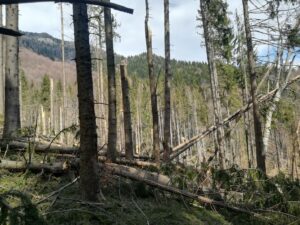Romania needs new technical solutions to protect its forests from the devastating effects of climate change, shows a WWF analysis within the ClimaFORCEE LIFE project. These solutions should then be promoted and implemented in its forestry practices, to limit the impact of extreme phenomena and to make disruptions manageable.
Several extreme natural phenomena currently affect our forests, causing wind and snow-related tree falls, rind insect attacks, defoliations, forest fires, frozen rains, torrential floods or avalanches.
To better understand the reality in the field, WWF made a questionnaire regarding the main disruptions (natural hazards) that affect the stability of the forestry ecosystems in Romania. It was addressed to the specialists involved in forestry activities: forest management, research, forestry and environment control authorities, protected areas administrations and NGOs.
The initial results show that 80% of the participants confronted with such phenomena in their professional activity and they need a different forest management approach to deal with them. Addressing the effects of these disruptions is costly and has a major medium and long-term impact on the social and economic environments.
The final results, which will be included in a good-practice guide for forest management, will be debated within working groups and at national and regional public consultations.
Context:
Climate change is a worldwide problem. These phenomena got more intense and determine, as time goes by, changes of different climatic parameters from a region to another.
Our current regional and national problems are generated by a rapid change of these climatic parameters and the resulted changes impact forests as well.
About the project:
WWF is involved in the regional project LIFE19 CCA/SK/001276 CLIMAFORCEELIFE which, in Romania, aims to identify the main extreme climatic phenomena that affect the Romanian forests. We will analyze the existing regional forest management models and create a good-practice guide for forest management that takes into account the identified extreme climatic phenomena.
Photo: Livia Cimpoeru







